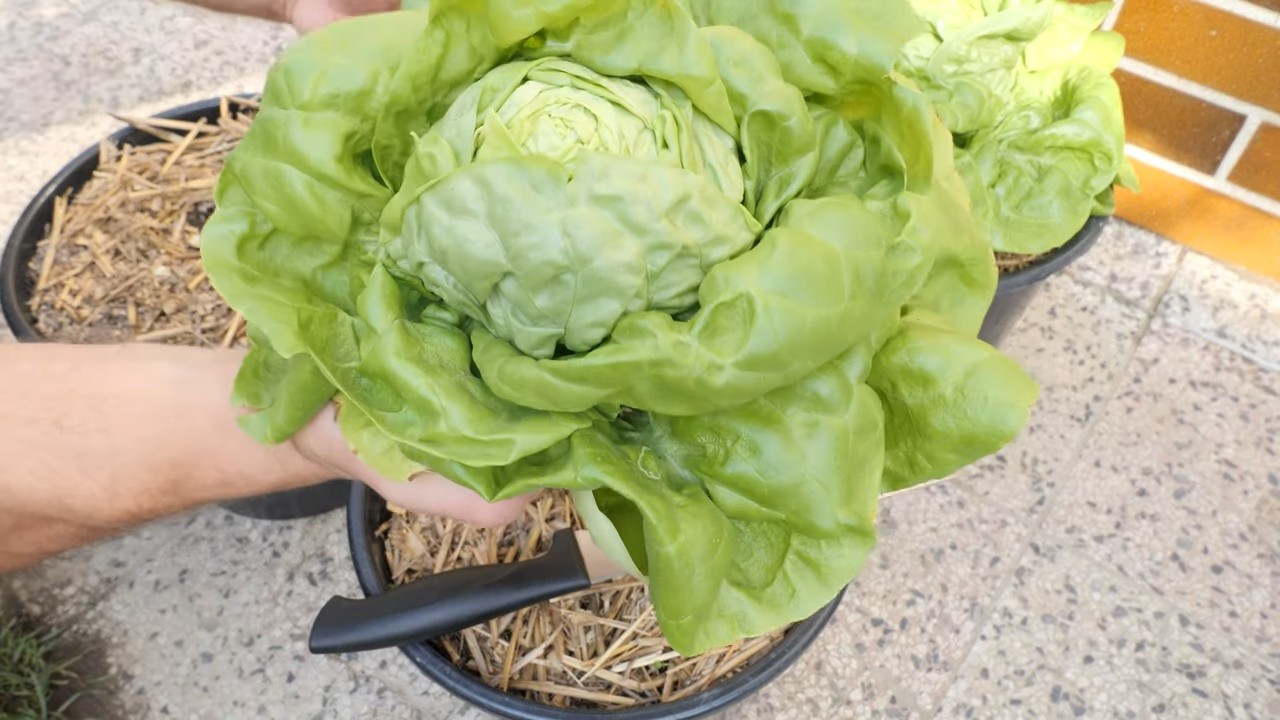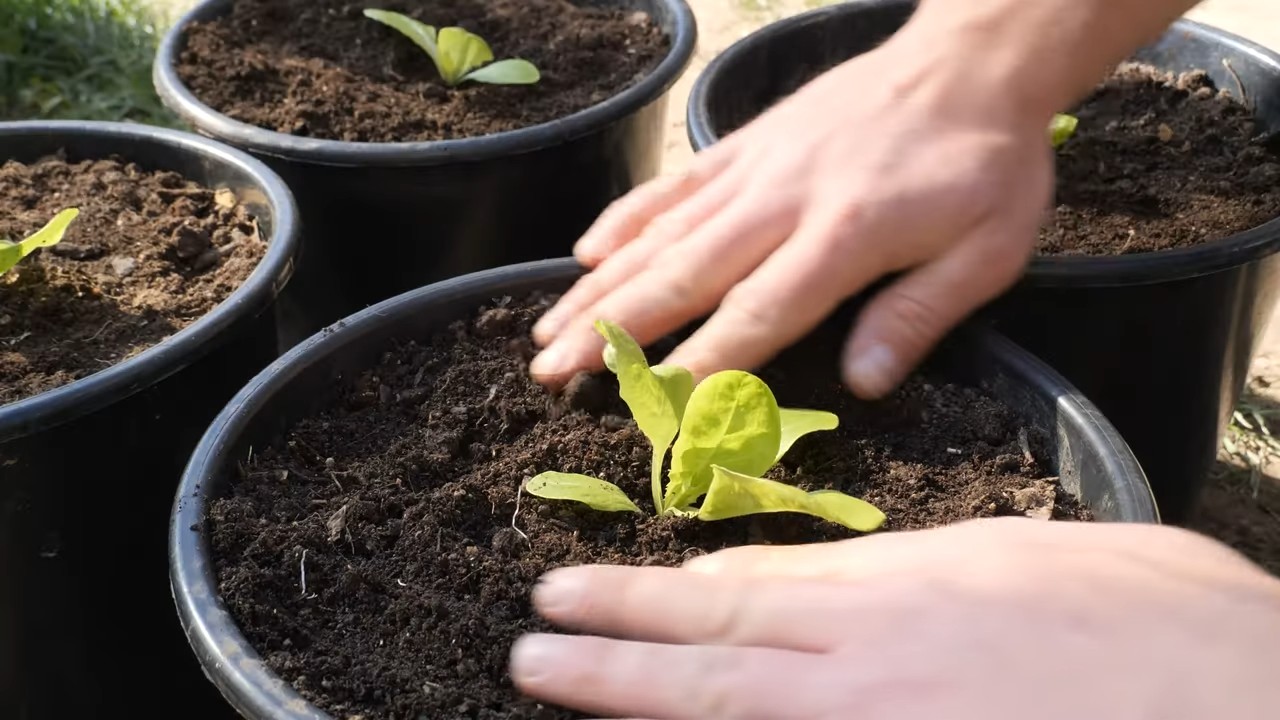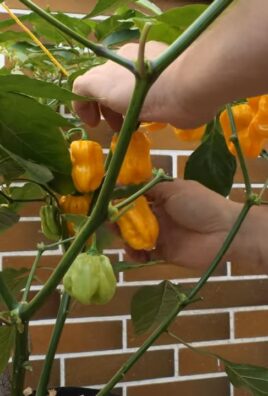Growing Lettuce in Pots: Imagine stepping outside your door and snipping fresh, crisp lettuce for your salad, sandwich, or even a vibrant green smoothie. Sounds idyllic, right? Well, it’s more achievable than you think, even if you don’t have acres of land! For centuries, humans have cultivated edible plants in containers, from the hanging gardens of Babylon to the humble window boxes of today. This practice connects us to a long line of resourceful gardeners who found ways to bring nature closer to home.
But why should you consider growing lettuce in pots? In today’s fast-paced world, access to fresh, healthy produce can be a challenge. Store-bought lettuce often travels long distances, losing flavor and nutrients along the way. Plus, let’s be honest, it can be expensive! This DIY guide will empower you to bypass the grocery store and cultivate your own delicious lettuce, right on your patio, balcony, or even a sunny windowsill. I’m going to share some simple, effective tricks and hacks that will have you harvesting a bounty of leafy greens in no time. Get ready to unleash your inner gardener and enjoy the satisfaction of growing your own food!

Growing Lettuce in Pots: A Beginner’s Guide to Fresh Greens on Your Patio
Hey there, fellow gardening enthusiasts! I’m so excited to share my experience with growing lettuce in pots. It’s seriously one of the easiest and most rewarding things you can do, even if you’re a complete newbie like I was. Imagine fresh, crisp lettuce right outside your door, ready for salads, sandwiches, or whatever your heart desires. Let’s dive in!
Choosing the Right Lettuce Variety
Okay, first things first, you need to decide what kind of lettuce you want to grow. There are tons of options, but some are definitely better suited for container gardening than others. Here are a few of my favorites:
* Loose-leaf lettuce: These are my go-to because you can harvest leaves as you need them, and they keep producing for weeks. ‘Black Seeded Simpson’, ‘Red Sails’, and ‘Oak Leaf’ are all fantastic choices.
* Butterhead lettuce: These form loose heads and have a wonderfully buttery texture. ‘Buttercrunch’ and ‘Tom Thumb’ are popular and relatively compact.
* Romaine lettuce: While they get a bit bigger, you can still grow romaine in pots, especially if you choose a smaller variety like ‘Little Gem’.
* Avoid Head Lettuce (Initially): While iceberg lettuce is tempting, I recommend avoiding it when you’re starting out. Head lettuce requires more space and specific conditions, making it a bit trickier for container gardening.
Gathering Your Supplies
Alright, now let’s get our hands dirty (well, almost!). Here’s what you’ll need to get started:
* Pots: Choose pots that are at least 6 inches deep and wide. Bigger is generally better, as it gives the lettuce roots more room to grow. Make sure your pots have drainage holes! This is super important to prevent waterlogging.
* Potting Mix: Don’t use garden soil! It’s too heavy and doesn’t drain well in containers. Instead, opt for a high-quality potting mix specifically designed for containers. I like to use a mix that contains peat moss, perlite, and vermiculite.
* Lettuce Seeds or Seedlings: You can start from seeds or buy seedlings from your local garden center. Seeds are cheaper, but seedlings will give you a head start.
* Watering Can or Hose: You’ll need a way to water your lettuce regularly. A watering can with a gentle rose head is ideal.
* Fertilizer (Optional): A balanced liquid fertilizer can help your lettuce grow strong and healthy.
* Trowel or Small Shovel: For planting seeds or seedlings.
* Gardening Gloves (Optional): To keep your hands clean.
Planting Your Lettuce
This is where the magic happens! Follow these steps to plant your lettuce:
1. Prepare the Pots: Fill your pots with potting mix, leaving about an inch of space at the top. Gently pat down the soil.
2. Sowing Seeds (If Starting from Seed): Sprinkle the lettuce seeds evenly over the surface of the soil. Cover them with a very thin layer of potting mix (about 1/4 inch). Gently water the soil to moisten it.
3. Planting Seedlings (If Using Seedlings): Dig a small hole in the soil that’s slightly larger than the root ball of the seedling. Gently remove the seedling from its container and loosen the roots a bit. Place the seedling in the hole and fill in around it with potting mix. Gently pat down the soil.
4. Water Thoroughly: Water the pots thoroughly after planting, making sure the soil is evenly moist.
5. Label Your Pots: It’s a good idea to label your pots with the type of lettuce you planted and the date. This will help you keep track of your progress.
Caring for Your Lettuce
Now that your lettuce is planted, it’s time to give it some TLC. Here’s what you need to do:
1. Watering: Lettuce needs consistent moisture to thrive. Water your pots whenever the top inch of soil feels dry to the touch. Avoid overwatering, as this can lead to root rot. I usually water every day or two, depending on the weather.
2. Sunlight: Lettuce prefers partial shade, especially during the hottest part of the day. If you live in a hot climate, try to place your pots in a location that gets morning sun and afternoon shade. In cooler climates, you can give your lettuce more sun.
3. Fertilizing (Optional): If you want to give your lettuce a boost, you can fertilize it every two weeks with a balanced liquid fertilizer. Follow the instructions on the fertilizer label.
4. Weeding: Keep an eye out for weeds and remove them as soon as you see them. Weeds can compete with your lettuce for nutrients and water.
5. Pest Control: Lettuce can be susceptible to pests like aphids and slugs. Check your plants regularly for signs of infestation. If you find pests, you can try spraying them with insecticidal soap or hand-picking them off the plants. I’ve found that a strong blast of water from the hose can also dislodge aphids.
6. Bolting: Bolting is when lettuce plants start to produce flowers and become bitter. This usually happens when the weather gets too hot. To prevent bolting, try to keep your lettuce plants cool and well-watered. You can also choose bolt-resistant varieties.
Harvesting Your Lettuce
This is the best part! You can start harvesting your lettuce as soon as the leaves are big enough to eat.
1. Loose-Leaf Lettuce: For loose-leaf lettuce, you can harvest individual leaves as you need them. Simply snip off the outer leaves with scissors or your fingers, leaving the inner leaves to continue growing.
2. Butterhead and Romaine Lettuce: For butterhead and romaine lettuce, you can harvest the entire head when it’s mature. Cut the head off at the base of the plant with a sharp knife.
3. Harvesting Time: Harvest your lettuce in the morning, when the leaves are crisp and cool.
4. Washing and Storing: Wash your lettuce thoroughly after harvesting and store it in the refrigerator in a plastic bag or container. It will usually keep for about a week.
Troubleshooting
Even with the best care, you might encounter some problems when growing lettuce in pots. Here are a few common issues and how to fix them:
* Yellowing Leaves: This can be caused by overwatering, underwatering, or nutrient deficiencies. Check the soil moisture and adjust your watering accordingly. If you suspect a nutrient deficiency, try fertilizing your lettuce with a balanced liquid fertilizer.
* Wilting Leaves: This is usually a sign of underwatering. Water your lettuce thoroughly and make sure the soil is evenly moist.
* Leggy Growth: This means your lettuce isn’t getting enough sunlight. Move your pots to a sunnier location.
* Bitter Taste: This is usually caused by bolting. Try to keep your lettuce plants cool and well-watered to prevent bolting. You can also choose bolt-resistant varieties.
* Pests: As mentioned earlier, lettuce can be susceptible to pests like aphids and slugs. Check your plants regularly for signs of infestation and take action as needed.
Extending Your Lettuce Season
Want to enjoy fresh lettuce for as long as possible? Here are a few tips for extending your lettuce season:
* Succession Planting: Plant new lettuce seeds or seedlings every few weeks to ensure a continuous harvest.
* Choose Bolt-Resistant Varieties: As mentioned earlier, bolt-resistant varieties are less likely to bolt in hot weather.
* Provide Shade: During the hottest part of the day, provide shade for your lettuce plants to keep them cool. You can use shade cloth or move your pots to a shadier location.
* Cold Frames or Greenhouses: In colder climates, you can use cold frames or greenhouses to protect your lettuce plants from frost and extend the growing season.
Advanced Tips for Lettuce Growing
Once you’ve mastered the basics, you can try these advanced tips to take your lettuce growing to the next level:
* Companion Planting: Plant lettuce with companion plants like carrots, radishes, and onions. These plants can help deter pests and improve the growth of your lettuce.
* Soil Testing: Test your soil to determine its pH and nutrient levels. This will help you choose the right fertilizer and amendments for your lettuce.
* Composting: Add compost to your potting mix to improve its fertility and drainage.
* Seed Saving: Save seeds from your favorite lettuce varieties to grow them again next year.
Final Thoughts
Growing lettuce in pots is a simple and rewarding way to enjoy fresh greens right at home. With a little bit of care and attention, you can have a continuous supply of delicious lettuce for salads, sandwiches, and more. So, grab some pots, seeds, and

Conclusion
So, there you have it! Growing lettuce in pots is not only achievable, it’s downright rewarding. Forget those limp, overpriced greens from the supermarket. Imagine stepping outside your door and harvesting crisp, vibrant lettuce leaves whenever you need them. This DIY trick transforms even the smallest balcony or patio into a thriving salad garden.
Why is this a must-try? Because it puts you in control. You choose the variety, you control the growing conditions, and you harvest at peak freshness. Plus, it’s incredibly satisfying to nurture something from seed to table. It’s a small act of self-sufficiency that connects you to the natural world, even in the midst of a busy urban life.
But don’t stop there! Experiment with different lettuce varieties. Try a mix of loose-leaf lettuces like ‘Black Seeded Simpson’ and ‘Red Sails’ for a colorful and flavorful salad blend. Or, go for a crisphead variety like ‘Iceberg’ if that’s your preference. You can also interplant your lettuce with other herbs like basil or chives to create a companion planting system that benefits both. Consider adding some edible flowers like pansies or nasturtiums for a beautiful and tasty garnish.
For those looking for a continuous harvest, succession planting is key. Sow a new batch of seeds every two weeks to ensure a steady supply of fresh lettuce throughout the growing season. And don’t forget to protect your pots from extreme weather conditions. A simple cold frame or row cover can extend your growing season well into the fall.
Growing lettuce in pots is more than just a gardening project; it’s an investment in your health, your well-being, and your connection to nature. It’s a simple, accessible way to bring fresh, delicious food into your life, no matter where you live.
We’re confident that you’ll find this DIY trick to be a game-changer. So, grab some seeds, a pot, and some soil, and get started today! We can’t wait to hear about your experiences. Share your photos and stories with us in the comments below. Let’s create a community of pot-grown lettuce enthusiasts! Tell us what varieties you’re growing, what challenges you’ve faced, and what tips you’ve discovered. Together, we can all become better gardeners and enjoy the bounty of our own little pot gardens. Happy growing!
Frequently Asked Questions (FAQ)
What kind of pot is best for growing lettuce?
The ideal pot for growing lettuce should be at least 6 inches deep and wide. This provides enough space for the roots to develop properly. Terracotta pots are a good choice because they allow for good drainage, but plastic pots are also suitable and tend to retain moisture better. Make sure the pot has drainage holes to prevent waterlogging, which can lead to root rot. Consider the size of the lettuce variety you’re planting. Larger varieties may require larger pots. For a continuous harvest, you might even consider using a long rectangular planter to grow multiple lettuce plants at once.
What type of soil should I use for growing lettuce in pots?
Lettuce thrives in well-draining, nutrient-rich soil. A good potting mix specifically formulated for vegetables is ideal. Avoid using garden soil, as it can be too heavy and compact in pots, hindering root growth. You can also amend your potting mix with compost or other organic matter to improve its fertility and drainage. A slightly acidic to neutral pH (around 6.0 to 7.0) is optimal for lettuce growth.
How often should I water my lettuce plants in pots?
Lettuce needs consistent moisture to thrive, but it doesn’t like to be waterlogged. Water your lettuce plants whenever the top inch of soil feels dry to the touch. In hot weather, you may need to water them daily. Water deeply, ensuring that the water drains out of the drainage holes. Avoid overhead watering, as this can promote fungal diseases. Instead, water at the base of the plant. Mulching around the plants can help retain moisture and suppress weeds.
How much sunlight does lettuce need when grown in pots?
Lettuce prefers partial shade, especially during the hottest part of the day. While it needs sunlight to grow, too much direct sun can cause the leaves to wilt and become bitter. Aim for at least 4-6 hours of sunlight per day. If you live in a hot climate, consider placing your lettuce pots in a location that receives morning sun and afternoon shade. You can also use shade cloth to protect your plants from intense sunlight.
How do I fertilize lettuce grown in pots?
Because lettuce is a fast-growing crop, it benefits from regular fertilization. Use a balanced liquid fertilizer diluted to half strength every two to three weeks. Alternatively, you can incorporate slow-release fertilizer granules into the potting mix at planting time. Avoid over-fertilizing, as this can lead to leggy growth and bitter-tasting leaves. Organic fertilizers, such as compost tea or fish emulsion, are also excellent choices.
How do I harvest lettuce from pots?
You can start harvesting lettuce leaves as soon as they are large enough to eat, typically when they are about 4-6 inches long. For loose-leaf varieties, simply snip off the outer leaves, leaving the inner leaves to continue growing. This cut-and-come-again method allows you to harvest lettuce continuously for several weeks. For head lettuce varieties, harvest the entire head when it is firm and well-formed. Harvest in the morning, when the leaves are crisp and hydrated.
What are some common pests and diseases that affect lettuce grown in pots, and how can I prevent them?
Common pests that affect lettuce include aphids, slugs, and snails. You can control aphids with insecticidal soap or by handpicking them off the plants. Slugs and snails can be trapped with beer traps or by handpicking them at night. Diseases that can affect lettuce include downy mildew and powdery mildew. To prevent these diseases, ensure good air circulation around the plants, avoid overhead watering, and remove any infected leaves promptly. Using a copper fungicide can also help prevent fungal diseases.
Can I grow lettuce indoors in pots?
Yes, you can grow lettuce indoors in pots, but you’ll need to provide adequate light. A sunny windowsill that receives at least 6 hours of direct sunlight per day is ideal. If you don’t have enough natural light, you can supplement with grow lights. Use a full-spectrum grow light and position it a few inches above the plants. Keep the soil consistently moist and fertilize regularly. Indoor lettuce may not grow as quickly or as large as outdoor lettuce, but it’s still a great way to enjoy fresh greens year-round.
What are some good companion plants for lettuce in pots?
Lettuce benefits from being planted alongside certain companion plants. Marigolds deter nematodes and other pests. Radishes help to break up the soil and deter flea beetles. Carrots attract beneficial insects that prey on aphids. Herbs like basil, chives, and mint can also help to repel pests and improve the flavor of lettuce. Avoid planting lettuce near fennel, as it can inhibit its growth.
How do I prevent lettuce from bolting (going to seed) in hot weather?
Bolting is a common problem with lettuce, especially in hot weather. To prevent bolting, choose heat-tolerant lettuce varieties. Provide shade during the hottest part of the day. Water regularly to keep the soil cool and moist. Harvest lettuce leaves frequently to encourage continued growth. You can also try planting lettuce in a location that receives morning sun and afternoon shade. Mulching around the plants can also help to keep the soil cool.




Leave a Comment